783 series
| 783 series | |
|---|---|
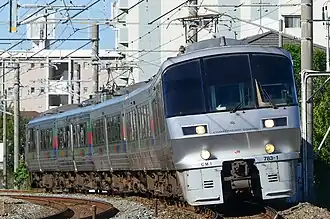 Set CM1, August 2017 | |
| In service | March 1988–Present |
| Manufacturer | JR Kyushu Kokura Works, Hitachi, Kinki Sharyo |
| Family name | Hyper Saloon |
| Constructed | 1988–1991 |
| Refurbished | 1994–2006 |
| Number built | 90 vehicles |
| Number in service | 86 vehicles (20 sets)[1] |
| Number scrapped | 4 vehicles[1] |
| Formation | 4/5 cars per trainset |
| Fleet numbers | CM1-5, CM11-15, CM21-25, CM31-35 |
| Operators | JR Kyushu |
| Depots | Minami-Fukuoka |
| Specifications | |
| Car body construction | Stainless steel |
| Car length | 21.05 m (69 ft 1 in) (end cars) 20 m (65 ft 7 in) (intermediate cars) |
| Width | 2,950 mm (116 in) |
| Doors | 1 per side |
| Maximum speed | 130 km/h (80 mph)[2] |
| Traction system | Thyristor drive |
| Electric system(s) | 20 kV AC 60 Hz |
| Current collection | Overhead catenary |
| Safety system(s) | ATS-SK, ATS-Dk |
| Track gauge | 1,067 mm (3 ft 6 in) |
The 783 series (783系) is an AC electric multiple unit train type operated on limited express services by Kyushu Railway Company (JR Kyushu) in Japan since March 1988.[2]
Design
The trains were built jointly by Hitachi, Kinki Sharyo, and JR Kyushu (at its Kokura factory).[3]
Formations
5-car Kamome sets (CM1–5)
The 5-car sets used on Kamome services are formed as follows.[4][5]
| Car No. | 1 | 2 | 3 | 4 | 5 |
|---|---|---|---|---|---|
| Designation | Thsc | M'1 | T0 | M2 | Mc |
| Numbering | KuRoHa 782 | MoHa 783 | SaHa 783 | MoHa 783-100 | KuMoHa 783 |
Cars 2 and 5 are each fitted with one scissors-type pantograph.
4-car Midori sets (CM11–15)
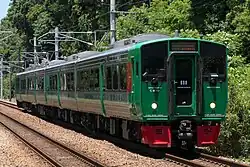
The 4-car sets used on Midori services are formed as follows.[4][5]
| Car No. | 11 | 12 | 13 | 14 |
|---|---|---|---|---|
| Designation | Thsc | T2 | M2 | Mc |
| Numbering | KuRoHa 782-100 | SaHa 783-200 | MoHa 783-100 | KuMoHa 783 |
Car 14 is fitted with one scissors-type pantograph.
4-car Huis Ten Bosch sets (CM21–25)
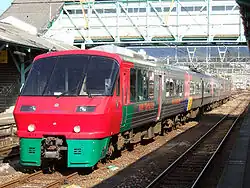
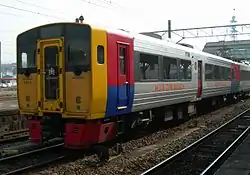
The 4-car sets used on Huis Ten Bosch services are formed as follows.[4][5]
| Car No. | 7 | 8 | 9 | 10 |
|---|---|---|---|---|
| Designation | Thsc | M2 | M1 | Tc1 |
| Numbering | KuRoHa 782-500 | MoHa 783-300 | MoHa 783-200 | KuHa 783-100 |
Car 9 is fitted with one scissors-type pantograph.
5-car Nichirin sets (CM31–35)
The 5-car sets used on Nichirin services are formed as follows.[4][5]
| Car No. | 1 | 2 | 3 | 4 | 5 |
|---|---|---|---|---|---|
| Designation | Thsc | M1 | T2 | M2 | Mc |
| Numbering | KuRoHa 782-500 | MoHa 783 | SaHa 783-200 | MoHa 783-100 | KuMoHa 783 |
Cars 2 and 5 are each fitted with one scissors-type pantograph.
Set CM35 normally operates as a 4-car set.
Past formations
The following formations were used from introduction in 1988 until the fleet was refurbished and reformed in 2000.[6]
9-car sets
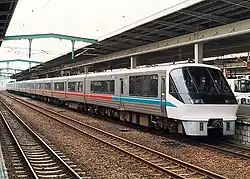
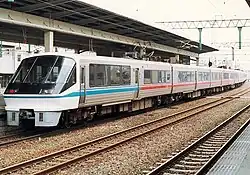
- 9-car sets used on Hyper Kamome services from March 1990 until June 1994
| Car No. | 1 | 2 | 3 | 4 | 5 | 6 | 7 | 8 | 9 |
|---|---|---|---|---|---|---|---|---|---|
| Numbering | KuRo 782 | MoHa 783 | SaHa 783-100 | MoHa 783 | SaHa 783-200 | MoHa 783 | SaHa 783-100 | MoHa 783-100 | KuMoHa 783 |
Cars 2, 4, 6, and 9 were each fitted with one scissors-type pantograph.
8-car sets
- 8-car sets used on Hyper Kamome services from March 1990 until June 1994
| Car No. | 1 | 2 | 3 | 4 | 5 | 6 | 7 | 8 |
|---|---|---|---|---|---|---|---|---|
| Numbering | KuRo 782 | SaHa 783-100 | MoHa 783 | SaHa 783-200 | MoHa 783 | SaHa 783-100 | MoHa 783-100 | KuMoHa 783 |
Cars 3, 5, and 8 were each fitted with one scissors-type pantograph.
7-car sets
- 7-car sets used on Ariake and Hyper Ariake services during busy seasons from 1 April 1988
| Car No. | 1 | 2 | 3 | 4 | 5 | 6 | 7 |
|---|---|---|---|---|---|---|---|
| Numbering | KuRo 782 | MoHa 783 | SaHa 783 | MoHa 783 | SaHa 783 | MoHa 783-100 | KuMoHa 783 |
Cars 2, 4, and 7 were each fitted with one scissors-type pantograph.
- 7-car sets used on Hyper Kamome services from 18 March 1993
| Car No. | 1 | 2 | 3 | 4 | 5 | 6 | 7 |
|---|---|---|---|---|---|---|---|
| Numbering | KuRo 782 | MoHa 783 | SaHa 783-200 | MoHa 783 | SaHa 783-100 | MoHa 783-100 | KuMoHa 783 |
Cars 2, 4, and 7 were each fitted with one scissors-type pantograph.
6-car sets
- 6-car sets used on Hyper Nichirin services from 18 March 1993
| Car No. | 1 | 2 | 3 | 4 | 5 | 6 |
|---|---|---|---|---|---|---|
| Numbering | KuRoHa 782 | SaHa 783 | MoHa 783 | SaHa 783-100 | MoHa 783-100 | KuMoHa 783 |
Cars 3 and 6 were each fitted with one scissors-type pantograph.
5-car sets
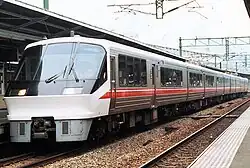
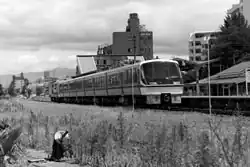
- 5-car sets used on Ariake and Super Ariake services from 1 April 1988
| Car No. | 1 | 2 | 3 | 4 | 5 |
|---|---|---|---|---|---|
| Numbering | KuRo 782 | MoHa 783 | SaHa 783 | MoHa 783-100 | KuMoHa 783 |
Cars 2, and 5 were each fitted with one scissors-type pantograph.
- 5-car sets used on Hyper Ariake services from March 1990 until July 1992 and on Tsubame services from 15 July 1992
| Car No. | 1 | 2 | 3 | 4 | 5 |
|---|---|---|---|---|---|
| Numbering | KuRo 782 | MoHa 783 | SaHa 783-200 | MoHa 783-100 | KuMoHa 783 |
Cars 2, and 5 were each fitted with one scissors-type pantograph.
4-car sets
- 4-car sets used on Hyper Ariake services from March 1990 until July 1992 and on Ariake and Hyper Nichirin services from 15 July 1992
| Car No. | 1 | 2 | 3 | 4 |
|---|---|---|---|---|
| Numbering | KuRoHa 782 | SaHa 783 | MoHa 783-100 | KuMoHa 783 |
Car 5 was fitted with one scissors-type pantograph.
3-car sets
3-car sets used on Ariake and Super Ariake services from 1 April 1988 until 1990
| Car No. | 1 | 2 | 3 |
|---|---|---|---|
| Numbering | KuRoHa 782 | MoHa 783-100 | KuMoHa 783 |
Car 3 was fitted with one scissors-type pantograph.
History
The 783 series trains were first introduced from 13 March 1988, initially branded as "Hyper Saloon".[5]
On 30 May 1989, the 783 series design was awarded the 1988 Laurel Prize by the Japan Railfan Club. A special award ceremony was held at platform 1 of Hakata Station on 26 August 1989.[6]
All cars were made no-smoking from the start of the revised timetable on 18 March 2007.[4]
References
- ^ a b JR電車編成表 2017夏 [JR EMU Formations - Summer 2017] (in Japanese). Japan: Kotsu Shimbunsha. May 2017. p. 358. ISBN 978-4-330-78717-6.
- ^ a b JR全車輌ハンドブック2009 [JR Rolling Stock Handbook 2009]. Japan: Neko Publishing. 2009. ISBN 978-4-7770-0836-0.
- ^ Saka, Masahiro (March 2014). "JR第1世代の車両・現況と概要" [JR 1st-generation rolling stock: Current situation and overview]. Tetsudō Daiya Jōhō Magazine (in Japanese). 43 (359): 22.
- ^ a b c d e JR電車編成表 2010夏 [JR EMU Formations - Summer 2010]. Japan: JRR. May 2010. pp. 204–205. ISBN 978-4-330-14310-1.
- ^ a b c d e "JR九州 新幹線・特急列車の運転体系概要" [Overview of JR Kyushu Shinkansen & Limited Express Operations]. Tetsudō Daiya Jōhō Magazine. 40 (323): 28–31. March 2011.
- ^ a b Nishimura, Takao (September 2011). "783系 「ハイパーサルーン」" [783 series "Hyper Saloon"]. Japan Railfan Magazine. 51 (605): 38–55.
External links
![]() Media related to JR Kyushu 783 at Wikimedia Commons
Media related to JR Kyushu 783 at Wikimedia Commons
